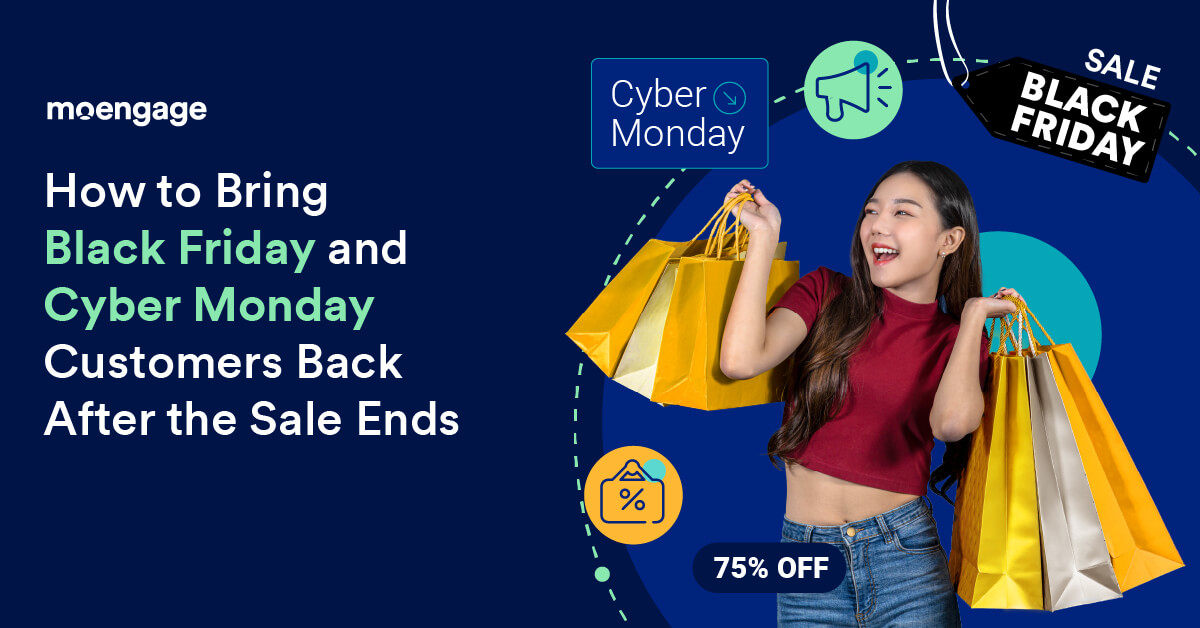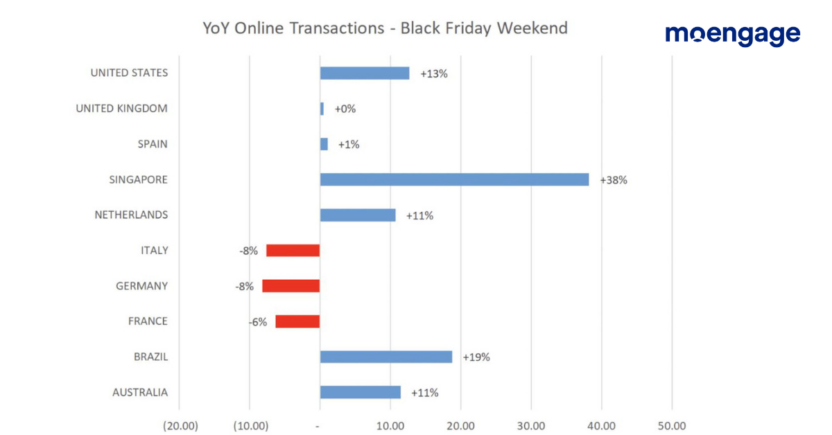How To Bring Black Friday And Cyber Monday Customers Back After The Sale Ends

Reading Time: 6 minutes
Black Friday. The season when sales are up, first-time website/app customers keep pouring in, and new customers are plentiful.
Data from 5,400 retailers in 60 countries on Black Friday 2022 showed that online transactions were up +4.8% year over year.
In the US, online transactions increased +13% during the Black Friday weekend (from Friday to Cyber Monday) compared to the year prior. When looking at sales leading up to the big shopping event, online transactions skyrocketed +374% on Black Friday compared to the average in October.
According to Shopify, Canada and the UK trail closely behind the US in BFCM sales. London joins the ranks of top BFCM shopping destinations globally, sharing the limelight with cities like Los Angeles and New York City.

However, much like Thanksgiving, once the turkey is consumed, tables are cleared, and your family disperses, the marketing space shows a visible slowdown. Ask any retail marketer; Black Friday is the most loved and hated period in their life. Most loved because of the “moolah” retailers can rake in. Hated because their sales spiraled down after this period. 64% of retailers say shoppers acquired during Black Friday have a shorter customer lifetime value than those obtained at any other time of the year. Most retailers focus on acquisition during this time (From Black Friday to New Year). This period brings in more customers than even Christmas. Where most brands fall short is to convert these seasonal discount-driven buyers into loyal customers. Retail marketers can use several strategies to ensure Black Friday customers don’t burn and churn.
Trends to Remember When Planning Customer Engagement Beyond Black Friday
To engage with your customers effectively post-holiday season, it is essential to understand how they’d like to shop and what has changed. For a marketer to retain customers they will gain throughout the holiday season, they must understand these changes and align with them rather than wait for 2024 to roll in.
The Early Black Friday Rush:
Consumers have started holiday shopping earlier than ever. A survey by Google stated that “as of mid-October, holiday shoppers globally had on average 21% of their holiday shopping complete.” Weary of the supply chain bottlenecks and the delay in their holiday purchase, consumers are motivated to buy early. Another reason could be that most consumers want access to discounts and sales before prices increase, or they miss out on the better deal.
Gen Z is spending big bucks:
Gen Z is the newest generation to join the workforce. They now have the purchasing power and are eager to stay on top of trends. However, this cohort carefully monitors their spending due to the pandemic and the fact that they’ve just started earning.
To gain their wallet share, retailers must carefully craft unique and meaningful experiences. Their expectations from brands are more than good quality products and efficient customer service. They want to engage actively and collaborate with brands.
Still not kicked curbside pickups to the curb:
Curbside pick-ups “picked up” in the last 4 years. An option where customers can order online and pick their product up at a location convenient to them. It’s the best of both worlds for them! Order online without waiting for 5-7 days and pick the product up immediately with no wait time.
Customer experience over brand loyalty:
The inflation-suffering customers value savings, convenience, brand values, and a personalized experience to determine where they buy from. The Consumer Insights for Holidays report also found that 16% of the surveyed customers tried a new brand this year. This creates an opportunity for more recent brands to gain and retain more customers during and after Black Friday.
Customers want to hear from you:
Customers receive billions of emails and SMS’ during Black Friday until the new year. This is why our assumption as marketers that customers do not want to receive more is logically sound. According to our survey, however, this doesn’t hold. Customers today want to stay connected with the brand they’ve purchased from. To effectively engage with your customers during and after Black Friday, marketers need to understand what kind of messages their customers expect.
23% of the customers surveyed for the “Personalization Pulse Check 2023” stated that they expect brands they purchase from to understand them and their needs, such as sharing relevant offers and content.
Buy Now Pay Later (BNPL):
This simple concept gained immense popularity during the pandemic. The pandemic fueled the need for saving even more. The fact that millennials and Gen Z customers find credit card options too risky has also contributed hugely to the rise of BNPL.
Social commerce:
Customers prefer a convenient experience. They have a very low tolerance for hurdles or obstacles that add an extra step to their journey with the brand. Most Gen Z and millennials primarily browse and discover trends and what they’d like to buy through social media. In this case, adding a link that redirects them to your website from the social media platforms just seems unnecessary. As the demand for a frictionless shopping experience grows, this has become an essential tool to increase holiday sales and help you improve brand recall post-holidays.
More customers buy sustainable:
Today’s customers are content with paying a higher price, getting a smaller discount, or even waiting more for a product if the brand they’re buying from practices sustainability. Customers want to associate themselves with environmentally conscious brands and feel good about knowing they’re playing their part in making a difference.
How to Keep Customers Returning after Black Friday to New Year?
1. Insights-led engagement:
Most marketers realize the value of personalization in their communication. Hyper-personalized communication is not only appreciated but also expected by the customer today.
Customers engaging with you during the Black Friday Cyber Monday duration give you access to first-party data. They are willing to share personal information in exchange for a unique experience. Marketers should use this data to personalize communication and send it at the right time, through the proper channels with relevant information.
2. Understand the buying motivators:
The shoppers who buy from you during Black Friday or Cyber Monday could give you an insight into why they purchased from your website, mobile app, or store. You can then use this information to draft intent-based marketing messages.
Motivator #1: Savings
Simple. This cohort bought your product because they’re saving money buying from you or the lowest-priced product. These customers buy from your sale collection, avail discounts, coupons, etc. To gain their loyalty, marketers should promote limited-time sales, push notifications with discounts, coupons for referrals, etc.
Motivator #2: You add to their brand identity
The Gen Z and millennial cohorts are a part of the “identity economy.” Before buying, they ask, “What is your brand helping me become? Some customers would want to buy a Chanel product because it makes them feel part of an elite community. Others may pride themselves on buying locally or buying only from vegan brands. This helps them align with their value system while making them feel part of a community. To gain loyalty, your brand message must communicate the values that resonate with your customers. This cohort is community-driven; therefore, promoting user-generated content might also tip them in your favour.
Motivator #3: Lack of options
Here, customers buy from you because there are no alternatives to what you sell. The customers in this segment are easily acquired but can quickly vanish if they see a cheaper or better quality alternative than yours.
The best way to keep these customers engaged is to create meaningful experiences. Offer a subscription-based model to them. Retailers could also provide value-added services like free or express delivery, convenient returns, discounts when they spend more with you etc.
Motivator #4: They shop with you because you are convenient
The customers in this cohort shop from you because you are convenient. Maybe you were offering the quickest delivery, or you had all the items they wanted in stock. Offer personalised product recommendations, restock updates, information on shorter delivery times, and more to retain this segment of buyers.
3. A lifecycle engagement strategy:
Adopt an approach that markets to each stage of the buyer’s journey across all channels, offline and online. Capitalise on micro-moments. Plan each stage from onboarding to activation to engagement to conversion and repeat purchase. A lifecycle engagement strategy not only results in a loyal customer base post Black Friday and Cyber Monday but also sustained growth for the brand.
4. Personalize, personalize, and personalize:
According to the recent survey report, “Personalization Pulse Check 2023” around 50.3% of consumers state that they expect deeper that is based on their purchase history and interest to engage with the brand. Brands that limit personalization to just <first_name> find it harder to keep their customers loyal.
5. Omnichannel all the way:
86% of shoppers regularly channel-hop across two channels, so 87% of retailers recognize the omnichannel marketing strategy as crucial for their business. Omnichannel engagement for retailers would mean being present at every channel, physical or digital, wherever your customers may be, and creating seamless, positive experiences for every customer across various channels.
The key to gaining and retaining customers post-Black Friday is seamless customer experience. From Black Friday to Christmas, most customers are discount-driven; the formula to getting them to buy from you is simple. Offer the lowest price or the highest discount. This doesn’t apply to the rest of the year. What will help you retain these customers all year round is understanding what they expect and providing a unique, personalized experience that adds value to them.













